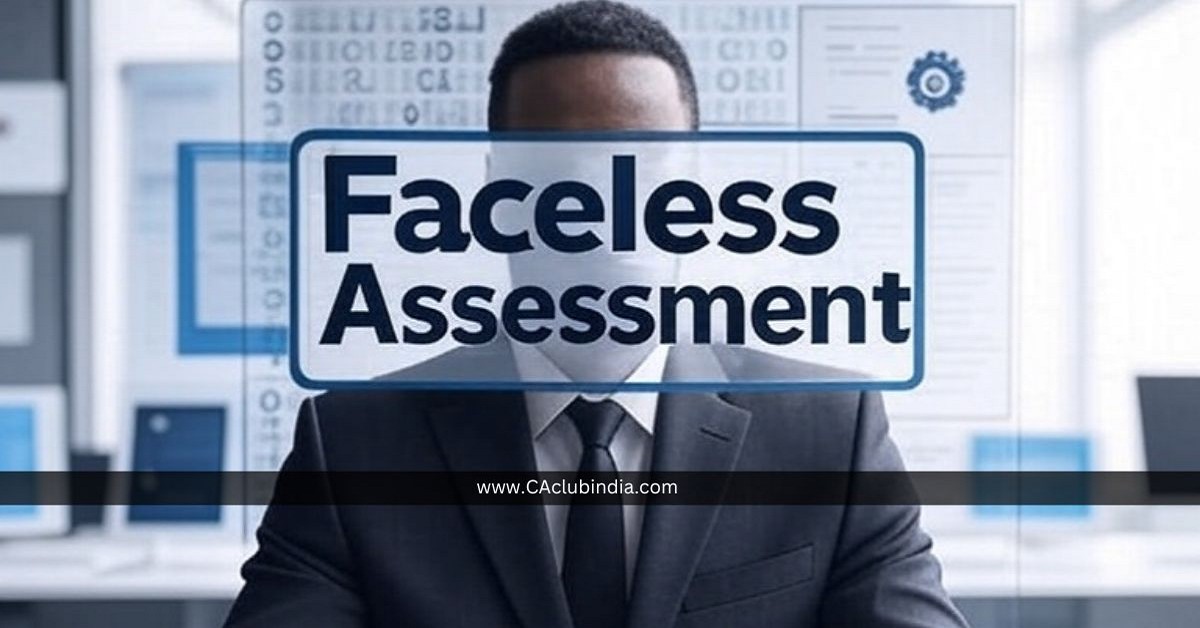Introduction
The Income Tax Act, 1961, has undergone continuous reforms over the years to enhance clarity, efficiency, and taxpayer compliance. Despite these efforts, ambiguities in certain provisions have often led to misuse such as wrongful claims of deductions, underreporting of income, or complete non-disclosure. Consequently, such practices trigger scrutiny and assessment proceedings by the tax authorities.
To address these challenges and to modernize the assessment mechanism, the Hon'ble Finance Minister of India introduced the concept of Electronic Assessment, commonly referred to as E-Assessment or E-Proceedings, during the Union Budget 2019, following the general elections. This initiative aimed to bring greater transparency, accountability, and efficiency into the assessment process, while minimizing direct interface between the taxpayer and the tax department.
The e-assessment scheme marked a significant shift from the traditional manual assessment system to a technology-driven, faceless, and jurisdiction-free model, aligning with the broader vision of Digital India and ease of doing business.

What is Assessment?
Under the Income Tax Act, 1961, the assessment process is designed to detect discrepancies and instances of non-compliance by the assessee. Common triggers for scrutiny by the Income Tax Department include mismatches in TDS returns, discrepancies in reported income or tax payments, failure to file income tax returns, and other inconsistencies in the taxpayer's financial disclosures.
Introduction of E-Assessment
The primary objective of introducing the E-assessment scheme under the Income Tax Act is to eliminate the need for direct interaction between taxpayers and tax authorities. This initiative aims to enhance transparency, ensure greater accountability, and improve overall efficiency in the assessment process. The system facilitates automated allocation of cases to designated assessment units, enabling a fully anonymous and digital review of returns. Notably, it eliminates the requirement for the taxpayer's physical presence at Income Tax offices for verification, thereby streamlining the compliance process.
Framework of Faceless Assessment under the Income Tax Act
Section 144B of the Income Tax Act, 1961 lays down the framework for faceless assessment, aiming to enhance efficiency, transparency, and fairness in the tax assessment process. Key features of this provision include:
1. Faceless Assessment Mechanism: Section 144B introduces a fully faceless assessment system, eliminating physical interface between taxpayers and tax authorities to minimize discretion and enhance transparency.
2. National Faceless Assessment Centre (NFAC): The NFAC functions as the central coordinating body, facilitating seamless and centralized communication in the faceless assessment process.
3. Specialized Assessment Units: Designated assessment units are tasked with examining returns, evaluating evidence, and preparing draft assessment orders without any direct interaction with the assessee.
4. Independent Review Units: Separate review units are responsible for verifying the draft orders for accuracy, consistency, and fairness before finalization.
5. Automated Case Allocation: Cases are assigned to assessment and review units through a system-driven automated mechanism, ensuring objective and unbiased distribution.
6. End to End Electronic Communication: All notices, submissions, orders, and other correspondences between the assessee and the department are exchanged exclusively through electronic means.
7. Virtual Hearing Opportunity: Taxpayers are entitled to request a hearing, which is conducted via video conferencing, thereby preserving the right to representation while maintaining the faceless framework.
8. Rectification Provision: The system provides a mechanism for rectification of mistakes in the assessment order, reinforcing the principles of natural justice and procedural fairness.
Centres and Units for Faceless Assessment
The Faceless Assessment Scheme, introduced under the Income Tax Act, 1961, mandates the establishment of specialized centres and functional units to streamline and standardize the assessment process. These entities are structured to function independently, ensuring objectivity, transparency, and fairness in tax administration.
1. National Faceless Assessment Centre (NFAC)
The NFAC acts as the central coordinating body for the entire faceless assessment mechanism. It is empowered to initiate assessments and manage the end-to-end workflow across different units and regions. The NFAC plays a pivotal role in maintaining consistency, standardizing processes, and ensuring uniform application of tax laws nationwide.
2. Regional Faceless Assessment Centres
Situated within the jurisdiction of the Principal Chief Commissioners of Income Tax, these regional centres facilitate the decentralized implementation of the faceless assessment process. They support the NFAC by managing region-specific cases, thereby reducing geographical limitations and enhancing administrative efficiency.
3. Assessment Units
Assessment Units are the core functional entities responsible for analyzing the taxpayer's submissions, identifying tax implications, collecting relevant information, and preparing draft assessment orders. These units operate independently from the assessee, thereby ensuring impartiality and minimizing subjective bias in the assessment process.
4. Verification Units
Verification Units assist the assessment process by conducting fact-based inquiries, verifying records, and gathering additional evidence, when required. These units provide factual support to the assessment units, reinforcing the credibility and accuracy of the assessments.
5. Technical Units
These units provide expert input on complex and specialized matters, including legal issues, accounting standards, forensic analysis, information technology, valuation, and transfer pricing. The technical units enhance the overall quality of assessments by bringing in domain-specific expertise.
6. Review Units
Review Units serve as a quality control layer in the faceless assessment framework. They critically examine the draft assessment orders to verify legal interpretations, factual accuracy, and computational correctness before finalization. Their role is instrumental in ensuring the fairness, accuracy, and legal integrity of the assessment process.
By establishing these specialized centres and function-specific units, the Faceless Assessment Scheme seeks to build a robust, efficient, and transparent tax administration system. The model not only promotes ease of compliance for taxpayers but also strengthens the integrity of revenue collection by minimizing human interface and discretion.
Procedure for E-Assessment under the Income Tax Act, 1961
The e-Assessment process under the Income Tax Act, 1961 follows a structured, fully electronic framework designed to enhance transparency, reduce human interface, and ensure procedural fairness. The process involves multiple function-specific units operating under the National e-Assessment Centre (NeAC). Below is a step-by-step outline of the standard procedure:
Step 1: Issuance of Notice under Section 143(2)
The process begins with the NeAC issuing a notice under Section 143(2) of the Act, intimating the assessee about the selection of their case for scrutiny under e-Assessment. The notice outlines the specific issues identified for examination.
Step 2: Submission of Response by the Assessee
The assessee is required to submit their response electronically to the NeAC within 15 days of receipt of the notice.
Step 3: Intimation Regarding e-Assessment
The NeAC formally communicates that the assessment proceedings will be conducted under the Faceless e-Assessment Scheme in cases where:
- A return is filed under Section 139 or in response to notices under Sections 142(1) or 148(1), and a notice under Section 143(2) has been served.
- A return has not been filed in response to a notice under Section 142(1).
- A reassessment notice has been issued under Section 148(1) and followed by a notice under Section 142(1).
Step 4: Case Allocation through Automated System
The case is allocated to a specific Assessment Unit (AU) within a Regional e-Assessment Centre via an automated allocation system based on artificial intelligence and machine learning algorithms to ensure objectivity and anonymity.
Step 5: Assistance Sought by the Assessment Unit
The AU may request the NeAC to:
- Obtain additional information or documents.
- Conduct inquiries through a Verification Unit (VU).
- Seek expert input from a Technical Unit (TU).
Step 6: Action by NeAC Based on AU's Request
In response to AU's request, NeAC will:
- Serve notices to the assessee or third parties to submit required documents or information.
- Route verification requests to a VU through automated allocation.
- Forward technical queries to a TU in another Regional Centre.
Step 7: Reports from Verification/Technical Units
Reports received from the VU or TU are relayed by the NeAC to the concerned AU for consideration in the assessment proceedings.
Step 8: Issuance of Show-Cause Notice under Section 144
If the assessee fails to comply with notices or directions under Sections 142(1), 142(2A), or other requisitions, the NeAC serves a show-cause notice under Section 144, providing an opportunity for the assessee to explain why a Best Judgment Assessment should not be completed.
Step 9: Draft Assessment Order by AU
The AU prepares a draft assessment order after examining all materials on record. If non-compliance is reported, a best judgment assessment may be drafted. The order includes details of any penalty proceedings proposed and is submitted to NeAC.
Step 10: Review and Risk-Based Evaluation by NeAC
NeAC evaluates the draft order using an automated risk management strategy. Based on the findings, it may:
- Finalize the assessment and issue a demand/refund notice.
- Issue a show-cause notice if modifications are proposed to the returned income.
- Forward the draft order to a Review Unit (RU) for further evaluation.
Step 11: Review by Review Unit
Upon receiving the draft, the RU reviews the assessment for factual accuracy, legal correctness, and computational validity. It may suggest modifications or concur with the order and relay its findings to NeAC.
If modifications are suggested, NeAC reallocates the case to a different AU for reconsideration and revision of the draft order.
Step 12: Response to Show-Cause Notice by Assessee
Where income modifications are proposed, the assessee is given an opportunity to respond to the show-cause notice. If no response is received, NeAC finalizes the assessment as per the draft. If a response is submitted, it is shared with the AU.
Step 13: Revised Draft Assessment Order
The AU considers the assessee's response and prepares a revised draft assessment order, which is then sent back to NeAC.
Step 14: Finalization of Assessment Order
NeAC finalizes the assessment based on the revised draft. If the order contains provisions prejudicial to the assessee, a further hearing opportunity is provided before finalization.
Step 15: Transfer of Records to Jurisdictional Assessing Officer
Upon completion, all electronic records are transferred by NeAC to the jurisdictional Assessing Officer for any subsequent actions, such as penalty proceedings or recovery. At any stage, with prior approval from the CBDT, the case may be transferred back to the jurisdictional AO by the Principal Chief Commissioner or Director General in charge of NeAC.
Faceless Assessment Under the Income Tax Act, 1961
Under the Income-tax Law, assessments are the foundation of the tax compliance and enforcement mechanism. The Income Tax Act, 1961 outlines several types of assessments, each serving a distinct purpose based on the taxpayer's compliance and disclosure. With the advent of the Faceless Assessment Scheme, many of these assessments are now conducted digitally, promoting transparency, efficiency, and minimizing physical interaction between taxpayers and tax authorities.
Below are the key types of assessments under the Act:
1. Summary Assessment - Section 143(1)
This is a preliminary assessment, conducted without requiring any interaction with the assessee. Known as a summary assessment, it involves basic verification of the return of income. The Assessing Officer (AO) may make the following adjustments based on the return filed:
- Correction of arithmetical errors,
- Detection of incorrect claims apparent from the return,
- · Adjustment of income based on tax audit report and Form 26AS, etc.
Time-Limit: This assessment must be completed within 9 months from the end of the financial year in which the return is filed.
2. Scrutiny Assessment - Section 143(3)
This is a detailed assessment, commonly referred to as scrutiny assessment. It is undertaken to ensure that the taxpayer has correctly reported income, claimed deductions accurately, and paid the correct amount of tax. During this process, the AO may:
- Verify books of accounts and supporting documents,
- Assess the genuineness of claims,
- Issue notices and conduct inquiries if required.
This assessment is now largely governed under the Faceless Assessment Scheme, where the selection, review, and finalization of scrutiny assessments are performed digitally without personal interaction.
3. Best Judgment Assessment - Section 144
This assessment is initiated when the assessee:
- Fails to file a return,
- Fails to comply with notices issued under Section 142(1) or 143(2),
- Fails to furnish necessary documents or information.
In such cases, the AO makes an assessment based on best judgment, using the information available on record. Under the faceless assessment regime, even such assessments are conducted electronically, ensuring procedural fairness and anonymity.
4. Income Escaping Assessment - Section 147
If the AO has reason to believe that any income has escaped assessment for any assessment year, they may reassess the income under Section 147. This is subject to the procedural safeguards outlined under Sections 148 to 153, including the issue of a notice and obtaining prior approval from the competent authority.
Income escaping assessment can cover:
- Previously undisclosed income,
- Incorrect application of exemptions or deductions,
- New evidence that emerges after original assessment.
This reassessment process is also integrated into the faceless system, ensuring consistency and audit trail in compliance.
Overview of Sections
|
S.No |
Section |
Assessment Type |
When |
|
1. |
Section 143(1) |
Summary Assessment |
AO* makes basic verification of the return of income. The AO may make some adjustments like Correction of arithmetical errors |
|
2. |
Section 143(3) |
Detailed/ Scrutiny Assessment |
AO undertaken to ensure that the taxpayer has correctly reported income, claimed deductions accurately, and paid the correct amount of tax. |
|
3. |
Section 144 |
Best Judgment Assessment |
Assessee fails to file his return or fails to reply to the notice issued u/s 142 & 143(3) or fails to provide necessary documents or information. |
|
4. |
Section 147 |
Income Escaping Assessment |
If the AO has reason to believe that any income has escaped assessment for any assessment year, they may reassess the income under Section 147 |
*AO = Assessing Officer.
Conclusion
The introduction of the Faceless E-Assessment Scheme under the Income Tax Act, 1961 marks a transformative step in India's tax administration. By eliminating physical interface and leveraging digital technologies, the government has addressed long-standing challenges of subjectivity, inefficiency, and lack of transparency in the assessment process. The robust legal framework under Section 144B, supported by dedicated units like the NFAC, AUs, VUs, TUs, and RUs, ensures that assessments are conducted in a structured, fair, and consistent manner.
This initiative not only enhances taxpayer convenience and confidence but also aligns with India's larger vision of Digital Governance and Ease of Doing Business. By incorporating automation, risk-based allocation, and audit trails, the faceless system significantly reduces the scope for arbitrariness and fosters a culture of voluntary compliance.
In essence, faceless assessment represents a paradigm shift from a person-centric system to a process-centric one reinforcing the core principles of transparency, accountability, and efficiency in tax administration. As the system continues to evolve, it is poised to become a benchmark for modern and equitable tax governance in a digital economy.







 CAclubindia
CAclubindia

